

After four years of visiting other places, it was time to return to Italy.
So, on September 15th, we flew to Rome, to stay for three days in the city and then to drive for a week in central Italy.

Having tried hotels in a number of areas in Rome, we decided to stay near the Vatican at Il Gattopardo Relais (ttp://www.ilgattopardorelais.it/). 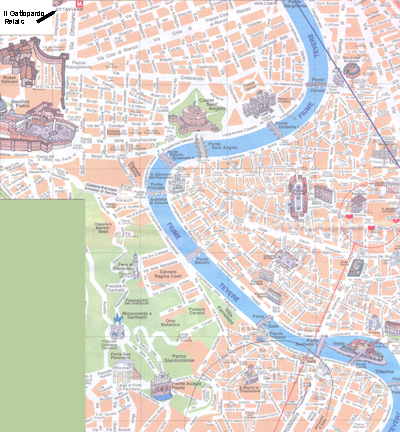
When we arrived in Rome (on Sept. 16) the weather was hot and sunny and by early afternoon we had settled in to our hotel and set out to explore; after looking at the Vatican area, we walked across the Tiber and all the way to one of our favourite destinations - Piazza Navona , where, after once again admiring Bernini’s magnificent Fountain of the Four Rivers, we stopped at a pizzeria on one of the side streets and enjoyed our first Italian meal – a simple but great pizza - before walking all the way back to our hotel to rest our weary feet and finally get some sleep.
The next morning (Sept. 17) we awoke rested (and comfortably adjusted to Italian time) and chose some new (and decidedly less traditionally touristy) destinations to explore. The first was the Historic Museum of the Liberation of Rome (at 145 Via Tasso near Piazza Manzoni ). The museum is housed in the building that was, during the Nazi occupation, the headquarters of the German Security Police and also the prison where they interrogated and tortured key members of the Roman Resistance. The building, looking very much as it did in 1944, now houses documents and photos that chronicle what took place there. Walking through the building is a chilling experience and most disturbing of all is entering the narrow isolation cells where prisoners, right after being tortured and condemned to death, were left alone to suffer in excruciating pain as they awaited transfer to their place of execution. With no light and no hope, many of these men engraved into the plaster walls with their fingernails prayers, literary quotes (such as verses from Dante’s Divine Comedy), parting words, and warnings. This is a museum without crowds and where the few people we noticed as we walked through said not a word. On the way out, I returned the single sheet of paper that was the simple guide to the building to the elderly man who had greeted us when we entered. There had been no entrance fee; so, assuming that donations were all that supported the upkeep, we gave him a few euros for which he was grateful. This was one of those moments when we wished that we could speak Italian; his deeply lined face and the look in his eye gave us the sense that he had been there during that horrific time – and that he had a story to tell.
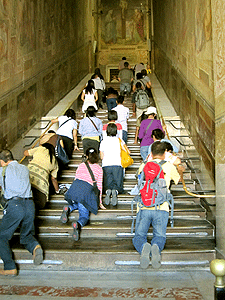
Once back in the sunshine, we went up to the end of the quiet and gloomy street, turned a corner, and came across an outwardly unimpressive building which people were lining up to enter. Curious, we joined them and, on entering, discovered that this building housed the Scala Sancta (Holy Stairs), which, according to Catholic/Christian tradition are the steps that led up to the praetorium of Pontius Pilate in Jerusalem, which Jesus Christ stood on during his Passion on his way to trial. The stairs, reputedly, brought to Rome in the 4th Century by St. Helena, the mother of Emperor Constantine the Great, have for centuries attracted Christian pilgrims. The devout (many sick and elderly) still climb those same 28 white marble steps on their knees, stopping to pray on each step, as they make their way up to the Sancta Sanctorum – the “Holiest of Holy Places”, the first private chapel of the Popes. Watching them gives a sense of the depth of Catholic faith, as it is experienced by the truly devout, and of the historical underpinnings of the Roman Catholic Church. The building, the frescoes, the mosaics and the stairs themselves, are, sadly, in desperate need of repair; the small areas (including the Sancta Sanctorum itself) where restoration has been done give a sense of the beauty that once was.
When we left, we quickly came across the magnificent (and, in sharp contrast, richly restored) Papal Archbasilica of St. John Lateran, the cathedral of the Church of Rome, Italy, which is the official ecclesiastical seat of the Bishop of Rome, the Pope. The light and brilliant splendor of this church is dimmed by the masses of tourists taking pictures; what was missing was that feeling of reverence that had so pervaded the Scala Santa. We left wanting a change of scene – and lunch.
A short ride on the Metro to the Spanish Steps and a quick walk to Via Della Croce brought us to one of our favourite restaurants, Ristorante Otello. On our first trip to Rome we had eaten there a couple of times; so, we reminisced about those other meals that had (with ingredients such as fresh arugula, buffalo cheese and zucchini flowers) changed so very much the way we now cook at home. We enjoyed the meal but the sense of novelty and discovery was replaced by nostalgia.
George has often talked of the Ossuary of the Capuchin Church, in Pza Barberini which had been closed during our past two trips to Rome. But now the renovations were completed; so, after lunch, it was off (finally) to see “the bones”. The crypt is located under Santa Maria della 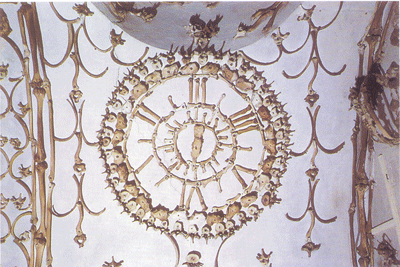 Concezione, a church commissioned by Pope Urban VIII in 1626. The pope's brother, Cardinal Antonio Barberini, who was a member of the Capuchin order, ordered in 1631 the remains of thousands of Capuchin friars exhumed and transferred from the friary Via dei Lucchesi to the crypt. The bones were
Concezione, a church commissioned by Pope Urban VIII in 1626. The pope's brother, Cardinal Antonio Barberini, who was a member of the Capuchin order, ordered in 1631 the remains of thousands of Capuchin friars exhumed and transferred from the friary Via dei Lucchesi to the crypt. The bones were 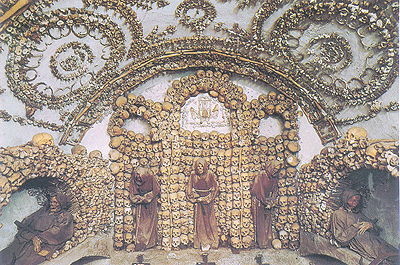 arranged along the walls, and the friars began to bury their own dead here, as well as the bodies of poor Romans, whose tomb was under the floor of the present Mass chapel. Here the Capuchins would come to pray and reflect each evening before retiring for the night.
arranged along the walls, and the friars began to bury their own dead here, as well as the bodies of poor Romans, whose tomb was under the floor of the present Mass chapel. Here the Capuchins would come to pray and reflect each evening before retiring for the night.
The crypt, or ossuary, now contains the remains of 4,000 friars buried between 1500-1870, during which time the Roman Catholic Church permitted burial in and under churches. The underground crypt is divided into five chapels, lit only by dim natural light seeping in through cracks, and small fluorescent lamps. The crypt walls are decorated in elaborate fashion with the remains, making this crypt a macabre work of art. Some of the skeletons are intact and draped with Franciscan habits, but for the most part, individual bones are used to create elaborate ornamental designs. The message (or lesson to be learned) from looking at the skeletons is captured in this quote: “What you are I once was; what I am you will be.”
After a short rest we journey over to Trastevere – another favorite area - for a supper of roasted artichokes, baked whiting and an artichoke risotto at La Tana de Noantri on Via della Paglia 1/3 at the corner P.za S. Egidio, Rome, Italy. The meal was excellent and the experience of sitting outside in this lively café was made especially enjoyable by the endless parade of attractive, well dressed people. As we headed back to the bus stop, though it was approaching midnight, there was no sign of any decline in the numbers of people milling around on this lovely Saturday night; we stopped to enjoy some talented musicians playing in a square.
 Sunday Sept 18 began with a perusal of the market stalls in Pza Risorgimento near the Vatican and a visit to Basilica Square for the weekly Papal blessing ; we arrived a bit late just as crowds were thinning out but we did see a recorded version on the large screens.
Sunday Sept 18 began with a perusal of the market stalls in Pza Risorgimento near the Vatican and a visit to Basilica Square for the weekly Papal blessing ; we arrived a bit late just as crowds were thinning out but we did see a recorded version on the large screens.
Recently, George had enthusiastically finished reading Mistress of the Vatican: The true story of Olimpia Maidalchini: the Secret Female Pope and I had just started reading it. The book, while an historical work, reads like a riveting novel. Set in the 1600s, it tells the story of Olimpia, the sister-in-law of Pope Innocent X, documenting how she acquired wealth and power, engaged in political intrigue, managed to get her brother-in-law elected pope, and took control of Vatican affairs. Much of the story was set in Rome and it very much flavored how we saw things during this visit.
Knowing that Olimpia had restored/restructured a palazzo called Palazzo Pamphili, in Piazza Navona to be her (and his) Roman residence, we had looked for it when we headed that way the first evening. Not having found it then, we headed back and this time found it (although it is now the Brazilian Embassy and closed to the public.)
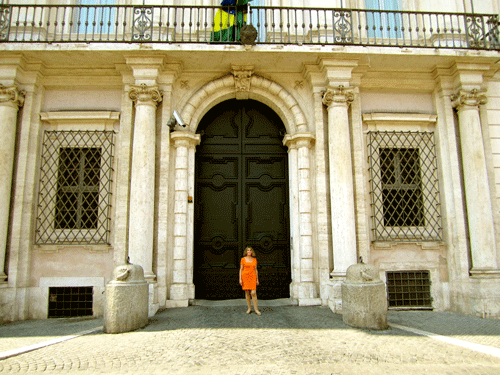
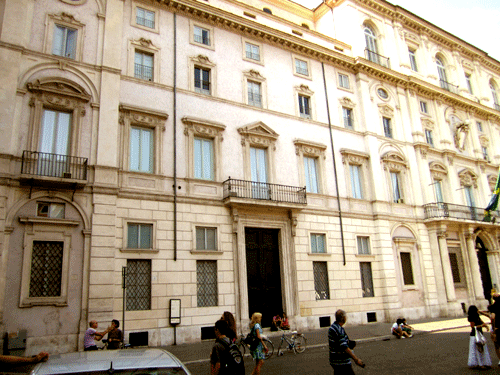
Then we headed back to the Spanish Steps for a supper of stuffed and deep fried zucchini flowers, calamari, stuffed lettuce, stuffed squid and risotto at another of our favourite restaurants Ristorante “Al 34” (http://www.ristoranteal34.it/).

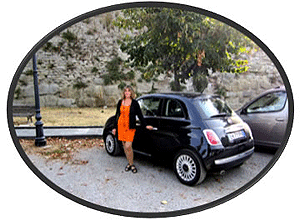
Monday, Sept 19 the shops were open so Tana shopped on nearby Via Ottaviano; then, we made by a quick visit to St Pietro’s Basilica before heading out to the airport to pick up our rental car, a Fiat 500 and drive to a hilltop town in Umbria.
The town, called Todi, is perched on a tall two-crested hill overlooking the east bank of the river Tiber, commanding distant views in every direction.
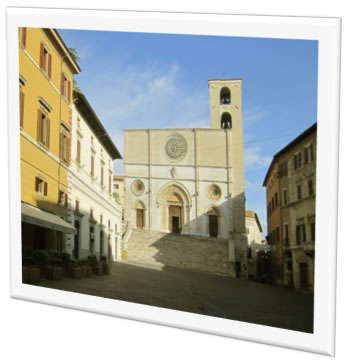
It is a small town with one hotel, Hotel Fonte Cesia - http://www.fontecesia.it/ so that’s where we stayed and, given that it was threatening to rain, it was also where we ate dinner. The service was slow but the food was excellent: pasta with anchovies, tomato, capers, and garlic; and a porcini risotto.
Almost all of Todi's main medieval monuments — the co-cathedral church (Duomo), the Palazzo del Capitano, the Palazzo del Priore and the Palazzo del Popolo — front onto the main square. It was a pretty town but not as interesting as we had expected; so, the next morning (Sept. 20) we headed off to Assisi which we had visited briefly on a previous trip and wanted to see again.
 It rained as we drove in to town and we wondered if we should change directions but the rain stopped the moment we turned off the ignition and the sun came out. After finding a room at Hotel Posta – http://www.hotelpostassisi.it/ we were off to walk through the town and to visit once again the old and new basilica of St Francis. The Franciscan monastery, il Sacro Convento, and the lower and upper church (Basilica inferiore e superiore) of St Francis were begun immediately after his canonization in 1228, and completed in 1253.
It rained as we drove in to town and we wondered if we should change directions but the rain stopped the moment we turned off the ignition and the sun came out. After finding a room at Hotel Posta – http://www.hotelpostassisi.it/ we were off to walk through the town and to visit once again the old and new basilica of St Francis. The Franciscan monastery, il Sacro Convento, and the lower and upper church (Basilica inferiore e superiore) of St Francis were begun immediately after his canonization in 1228, and completed in 1253.
Supper, at La Fortezza, included black truffles on toast, Pigeon with anchovy sauce, and a lovely dessert of biscotti which we dipped in Vin Santo.
The next day (Sept. 21) an hour’s drive around Perugia brought us to Cortona, a popular hillside town which we had not managed to visit on any previous trip. We took a look around and, because it was crowded with day-tripping tourists, we booked a room at Hotel Sabrina and headed out of town to Passignano on the north shore of Lago Trasimeno. It was a beautiful, hot, sunny day; so, it was nice to be on the lake. The town was quiet but we found a fabulous restaurant on the shore - Sottovento di Turcheria where we slowly and casually enjoyed: mixed seafood gratin; a fabulous salad of thin sliced mushroom, parmesan cheese and arugula drizzled with a balsamic glaze; and, gnocchi with tomatoes, mozzarella and basil pesto. It was one of the most memorable meals of this trip.

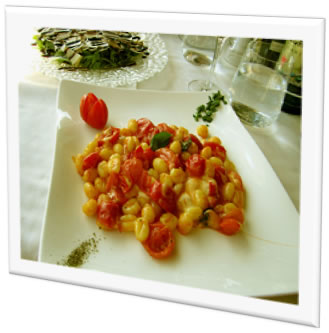
By the time we returned to Cortona the tourists had, as we had hoped, departed and the town had returned to the locals. Tana found a great outdoor patio restaurant, Nessum Dorma http://www.ristorantenessundorma.com/ where George enjoyed wild boar cooked in a merlot sauce and I had a great zucchini & tomato lasagna that was nicely thin because it had only a bottom and top layer of noodles and a mozzarella topping with a béchamel sauce.
The next morning (Sept. 22), we drove to another town we had not previously visited - Lucca which is situated on the river Serchio in a fertile plain near the Tyrrhenian Sea and is famous for its intact Renaissance-era town walls. Accommodation is limited and cars are generally kept outside the walls so we had a 20 minute walk to find what we were told was the only hotel that had an available room 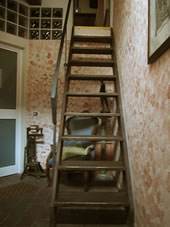 - Hotel Al Tuscany (operated by Claudio and Marina) http://www.altuscany.it/en
- Hotel Al Tuscany (operated by Claudio and Marina) http://www.altuscany.it/en
Situated on the top floor of a building, our room was a further flight up rickety stairs but, given the location, it was well worth the risk. The room itself, as long as you remembered to avoid hitting your head on the beamed ceiling, had a rustic charm about it. We booked it for two nights so that we could explore what looked like an interesting town and take a look at the surrounding region.
We walked through the town, which was the birthplace of Giacomo Puccini, admiring the architecture. While certainly a tourist destination, it never felt crowded.
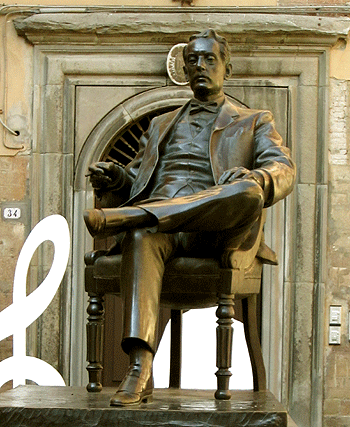
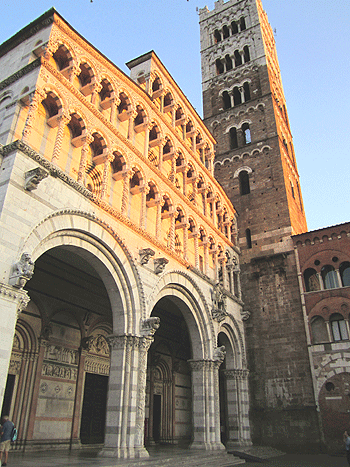
That evening we had supper at Ristorante Puccini http://www.ristorantepuccini.it/ - sitting in the patio directly across from what had been Puccini’s home. George had rabbit with olives and truffle sauce and Tana had a lovely Italian quiche.
The next morning, we got the car and drove through the hills to Via Reggio, a Riviera location of endless private beach resorts. It was remarkably boring; so, we drove inland to Carrera, which is famous for its Italian marble. 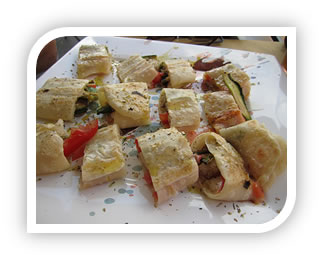

We stopped for lunch in the patio of a simple place called Pza Carrera where we enjoyed crepes rolled with cheese and/or meats, cut into portions and drizzled with balsamic glaze.
We walked over to the statue of the lion that was in the square (see photo at the beginning of this trip diary) and, after finding the house where Michelangelo stayed while he was searching for the right piece of marble out of which to carve the statue of David, we drove up into the hills to catch some glimpses of the open-face marble mining. The road was steep so we went only far enough to get a sense of the magnificence of the mountains – and to get a few photos. It’s sad to realize that the marble mined today is rarely used by artists or even by builders but rather ground into a powder to be used in the paper industry.

Back in Lucca we enjoyed a late supper at Trattoria da “Leo” http://www.trattoriadaleo.it/Home_en.html , George enjoying Guinea fowl and Juniper berries, and I, a contorni of boiled chard, peppers and roasted potatoes.
The next morning (Sept. 24) we drove south to Volterra where we had spent some days a few years ago and headed back to ‘our’ hotel Albergo Etruria
( http://albergoetruria.it/Hotel-Volterra/hotel-etruria.php) - a small Bed & Breakfast located in the historical centre, on the main shopping street and only 100 meters away from the famous Piazza dei Priori. We enjoyed wandering around and had a pleasant pasta lunch – a tagliatelle de Bosco (of the woods) with mushrooms & truffles. 
After dark we took a walk again around the town and up to the walls of the federal prison – an ancient, and starkly sinister looking building in which today some of the most notorious criminals serve out their life sentences. Then, we headed down for a late supper at Ristorante Da Beppino Di Senes Angelo where, sitting on the patio we enjoyed a great bottle of local wine and a truly local meal. George had a wonderful charcuterie of meat and pecorino cheese and I had a baked pecorino cheese. Then, after enjoying a smooth local grappa, we headed back to our room.
For our final night we drove for 5 hours, slowly winding drive through Tuscany and Lazio with a stop at Abbadia, to reach Viterbo, which is an hour from Fumincino Airport – and more importantly, the birthplace of Olimpia about whom we had been reading.
The historic center of the city is surrounded by medieval walls, still intact, built during the 11th and 12th centuries. Entrance to the walled center of the city is through ancient gates.
We booked a room at Hotel Roma - http://www.albergoromaviterbo.com/
Then we spent a couple of frustrating hours trying to find a tourist office to get some information about location of Olimpia’s house in the city and about nearby San Martino – the town which she had built and where her palazzo was – and where she was buried. Having finally found the tourist office and gotten that information, we could relax and enjoy the town.
We had a late supper at Il Labirinto, a restaurant where we had, on a previous visit, 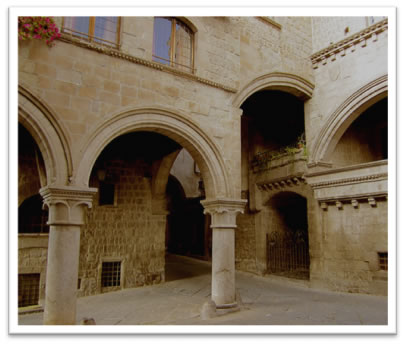 devoured a fabulous huge, thin crusted gorgonzola pizza. The restaurant looked just the same – a basic, local kind of place and the pizzas were just as amazing. So huge that they were larger than the big platters on which they were served and so thin that what little crust there was had a great crispy texture - they were great. I had a gorgonzola & tomato one and George ordered one that was ½ seafood & ½ peperoni.
devoured a fabulous huge, thin crusted gorgonzola pizza. The restaurant looked just the same – a basic, local kind of place and the pizzas were just as amazing. So huge that they were larger than the big platters on which they were served and so thin that what little crust there was had a great crispy texture - they were great. I had a gorgonzola & tomato one and George ordered one that was ½ seafood & ½ peperoni.
Back in our room that night we checked our book for details of Olimpia’s early life in Viterbo and of the nearby town of San Martino which, after marrying into the Pamphili family, she had focused on building. Early the next morning, we set out in search of the Palazzo which had belonged to the family of her first husband and where she had lived in her youth. We walked for some time through winding, poorly maintained residential streets and, when eventually we did locate the palazzo, all that we found was a seemingly deserted building that was drab, dirty and in disrepair. Only an inscription in Latin made it identifiable as the palazzo in which the young Olimpia had once proudly lived.
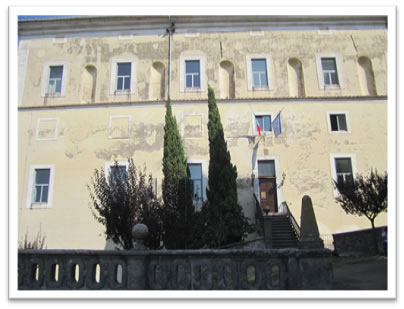 On our way to the airport, we took a side trip to San Marino and , by chance, parked our car right beside the Pamphili Palazzo. The sign outside indicated that this had indeed been Olimpia’s home and that there was an historical society dedicated to preservation but it also told us that the building was not open to the public except on Sundays when tours could be arranged. This was not Sunday and the building looked closed and deserted. Disappointedly, we walked around it and, in doing so, we found one unlocked door. When we walked in, it seemed deserted but, down a hallway, we came upon an office where a tourism official kindly said that he’d let us in. We were surprised when he simply unlocked the door for us and left, leaving us on our own - free to wander through the rooms. We came upon one very large room with a huge fireplace across from which there was a large framed portrait. We suspected that it was a portrait of Olimpia but the room was so dark that neither could we see it clearly or read the plaque; so, unable to figure out how to turn on lights, we pulled back the heavy draperies to let in some sunlight. And we discovered that this was, indeed, a portrait of Olimpia holding the hand of one of her daughters. Later, we entered another large room, also very dark, in which (after opening the drapes) we saw a portrait (see photo below) of her brother-in-law, Innocent X. This was, we figured, one of the rooms designated by her for the use of the pope during his frequent visits to the Pamphili Palace in San Martino.
On our way to the airport, we took a side trip to San Marino and , by chance, parked our car right beside the Pamphili Palazzo. The sign outside indicated that this had indeed been Olimpia’s home and that there was an historical society dedicated to preservation but it also told us that the building was not open to the public except on Sundays when tours could be arranged. This was not Sunday and the building looked closed and deserted. Disappointedly, we walked around it and, in doing so, we found one unlocked door. When we walked in, it seemed deserted but, down a hallway, we came upon an office where a tourism official kindly said that he’d let us in. We were surprised when he simply unlocked the door for us and left, leaving us on our own - free to wander through the rooms. We came upon one very large room with a huge fireplace across from which there was a large framed portrait. We suspected that it was a portrait of Olimpia but the room was so dark that neither could we see it clearly or read the plaque; so, unable to figure out how to turn on lights, we pulled back the heavy draperies to let in some sunlight. And we discovered that this was, indeed, a portrait of Olimpia holding the hand of one of her daughters. Later, we entered another large room, also very dark, in which (after opening the drapes) we saw a portrait (see photo below) of her brother-in-law, Innocent X. This was, we figured, one of the rooms designated by her for the use of the pope during his frequent visits to the Pamphili Palace in San Martino.
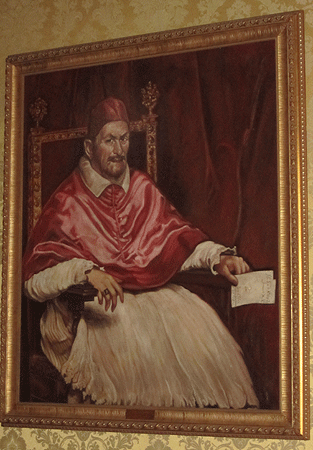
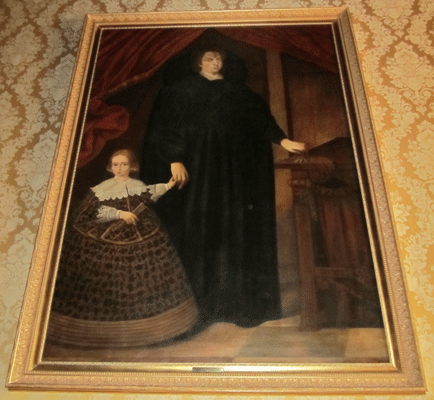
After leaving Olimpia’s Palazzo, we wandered across to the adjacent Church of San Martino where, after dying of the plague, she had been buried in the tomb she had already had prepared as her final resting place. We stayed only briefly in the church before walking down the steep hill into the quiet town of San Martino which appeared to have changed very little since Olimpia’s time.
Our visit to San Martino, largely because of that unexpected chance to see the inside of Palazzo Pamphili, turned out to be a highlight of this trip to Italy – and a fitting ending.
Flipping back through our book about Olimpia, we became aware of the extent to which what we experienced on our trip was tied into what we had learned about her life. Born in Viterbo in 1591, she had spent many years in Rome at the centre of historical and cultural events of the time, and finally returned to San Martino where in 1657 she died. The day of her death was September 26 which happened to be the date of our visit to San Martino. There is something unnerving about having, by chance, wandered alone through the Palazzo where she had died on that same day 354 years earlier.
We’re not sure what to make of that “coincidence” but we are now intrigued by the realization that much of what we saw in Rome at the beginning of our trip had been familiar to Olimpia and of her era. Like the pilgrims we had watched, she had climbed on her knees the Scala Sancta; she had gone to mass at the Papal Archbasilica of St. John Lateran; she lived on the Piazza Navona at the very time when Bernini was creating the famous Fountain of Four Rivers; she had attended St. Peter’s Basilica on Sundays; she had spent countless days, evenings (and some say nights) in Vatican City – in the private chambers of Pope Innocent X ,and she had developed an intensely close, competitive, complex relationship with the influential family of the previous pope (Urban VIII), interacting often with those members of the Barberini family who had been made Cardinals – including Cardinal Antonio Barberini who had, in 1631, ordered the remains of Capuchin friars to be exhumed and moved to the Crypt of the Capuchin Church to be made into the works of bone art that had so fascinated George.
Italy did it again for us. Now we wonder what we will find next time. Yes, we will return again!